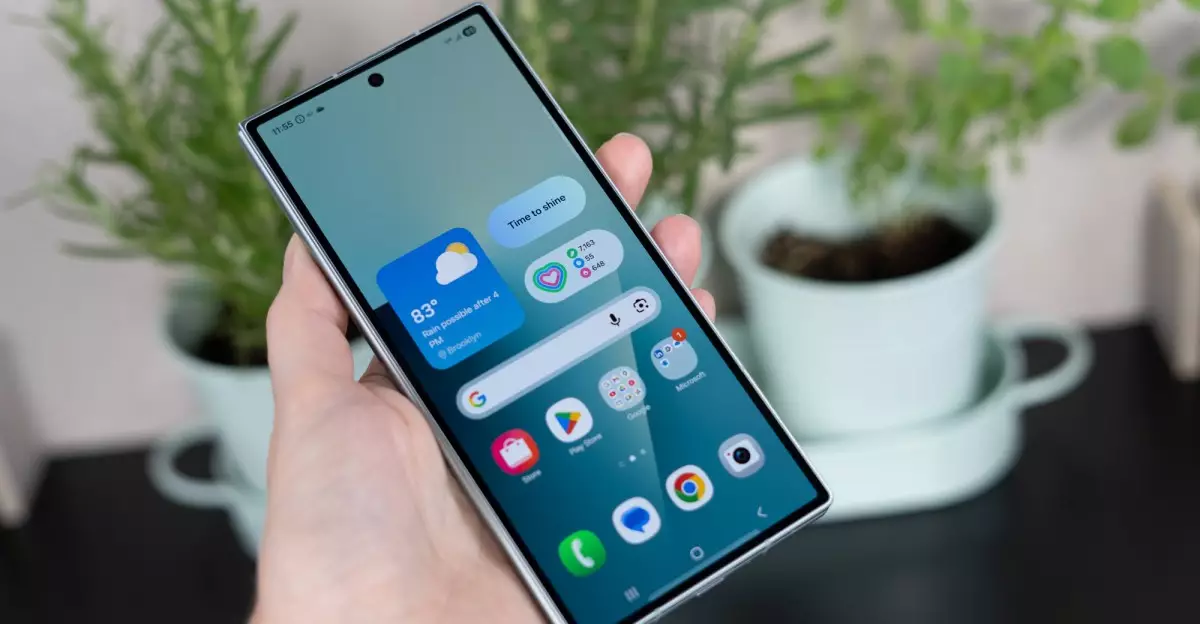Samsung’s latest flagship, the Galaxy Z Fold 7, emerges as a game-changer in the foldable smartphone market. While many have been quick to dismiss foldables as novelty gadgets, Samsung continues to refine its design and functionality, pushing the boundaries of what a phone can be. At a remarkably slim 8.9mm when folded, the Z Fold 7 not only challenges the perception of foldables being bulky, but it also blurs the line between smartphones and compact tablets. This design feat signals Samsung’s commitment to usability and aesthetic appeal, making the device more approachable to mainstream consumers who may have previously been wary of foldable technology.
The increase in outer screen size from 6.3 inches to 6.5 inches is a subtle yet impactful upgrade, providing a more natural user experience that rivals traditional phones. The device’s sleek profile ensures it resembles a standard premium phone when folded, which could significantly accelerate mass adoption among users who value convenience but desire the innovation that foldables offer. Moreover, the introduction of this reduced thickness demonstrates Samsung’s relentless pursuit of perfection—a reminder that even in saturated markets, innovation driven by thoughtful engineering can revive consumer interest and set new industry standards.
Pricing and Perks: Navigating the Premium Price Tag
Despite its remarkable design, the Galaxy Z Fold 7’s hefty starting price of $1,999.99 inevitably raises questions about affordability. The device positions itself firmly in the premium segment, but the value proposition hinges heavily on its features and the incentives offered at launch. Samsung is tapping into the power of trade-in deals and carrier promotions to soften the financial blow, but these discounts come with tight deadlines and conditions that savvy buyers must navigate carefully.
Trade-in incentives stand out as a particularly compelling aspect of the purchase process. Offering up to $1,000 credit against previous flagship models like the Galaxy Z Fold 6 or Galaxy S21 Ultra, Samsung effectively halves the price for early adopters willing to swap their older devices. While this is a lucrative offer, it is important to scrutinize how these incentives influence overall cost—who really benefits, and are the terms fair? Essentially, Samsung facilitates an instant reduction of the out-of-pocket cost, making the device more accessible, but potential buyers need to be attentive to the fine print, especially as carrier-specific trade-in deals differ significantly in how they reimburse.
Carriers are also escalating the trade-in game, with Verizon, AT&T, and T-Mobile offering up to $1,100 in monthly credits over 36 months. Such financing options seem appealing initially, but they lock consumers into long-term commitments with carrier plans, which may include hidden fees or restrictive service terms. The question remains whether these long-term installment plans truly make the device affordable, or merely spread out the expense without significant savings. This nuance is crucial for buyers who may prefer outright purchases or shorter-term financing, especially in an era where transparency in pricing is paramount.
Strategic Promotions and the “Use It or Lose It” Dilemma
Preorder promotions today underscore one vital lesson: timing and strategic planning are essential when investing in high-end tech. Samsung’s $50 accessory credit is an attractive perk, especially if you’re already considering buying a Galaxy Watch 8, earbuds, or protective cases. However, the “use it or lose it” clause associated with the additional $300 non-trade-in credit introduces a layer of urgency that may unduly pressure consumers into making quick decisions, sometimes leading to buyer’s remorse or impulsive purchases.
Retailers like Best Buy, Amazon, and Samsung’s online storefront are offering targeted deals—such as no-cost upgrades to the 512GB model and bundled gift cards—that provide real value but are time-sensitive. Interestingly, Amazon’s inclusion of a $300 gift card with each sale could be a masterstroke in boosting overall perceived value, giving consumers a reason to buy directly from the retailer rather than through carriers. Nonetheless, the discrepancy in storage options and pricing across different retailers signals a fragmented landscape. For consumers, this can be confusing and potentially misleading, especially if they’re not fully aware of the various terms and conditions associated with each outlet.
The choice between models—256GB versus 512GB—also reflects an underlying battle between affordability and capacity. While Samsung and some retailers offer the larger storage for free, operators like AT&T and Verizon stick with the base model at the same price point, prompting buyers to consider if the extra storage warrants the additional cost or if carrier restrictions influence their decision more than the device’s capabilities.
Industry Implications and Consumer Outlook
The launch of the Galaxy Z Fold 7 symbolizes a broader industry shift towards flexible form factors that prioritize portability without sacrificing functionality. Samsung’s improvements aren’t just incremental—they reflect a strategic effort to normalize foldables as mainstream devices capable of replacing traditional smartphones. This transition isn’t merely about hardware; it’s about reshaping consumer expectations and encouraging the adoption of more adaptable, versatile mobile solutions.
Yet, pricing remains a major hurdle. The $2,000+ entry point makes the Z Fold 7 a luxury rather than a necessity—at least for now. It raises critical questions about whether the average consumer is ready to embrace the foldable revolution, or if this frontier will remain confined to early adopters and tech enthusiasts. As the device’s price begins to stabilize with market penetration and potential future models, the industry will testify to whether foldables can achieve mass-market appeal.
Ultimately, Samsung’s marketing strategy, combining high-profile promotions with aggressive trade-in deals, demonstrates an astute understanding of consumer psychology. By creating a sense of urgency and offering tangible incentives, the brand aims to shift perceptions: yes, foldables are expensive, but with the right deals, they become just affordable enough to tempt a broader audience. This balancing act of innovation, marketing, and pricing will define the foldable segment’s future trajectory, and the Galaxy Z Fold 7 stands at the forefront of that evolution.


Leave a Reply